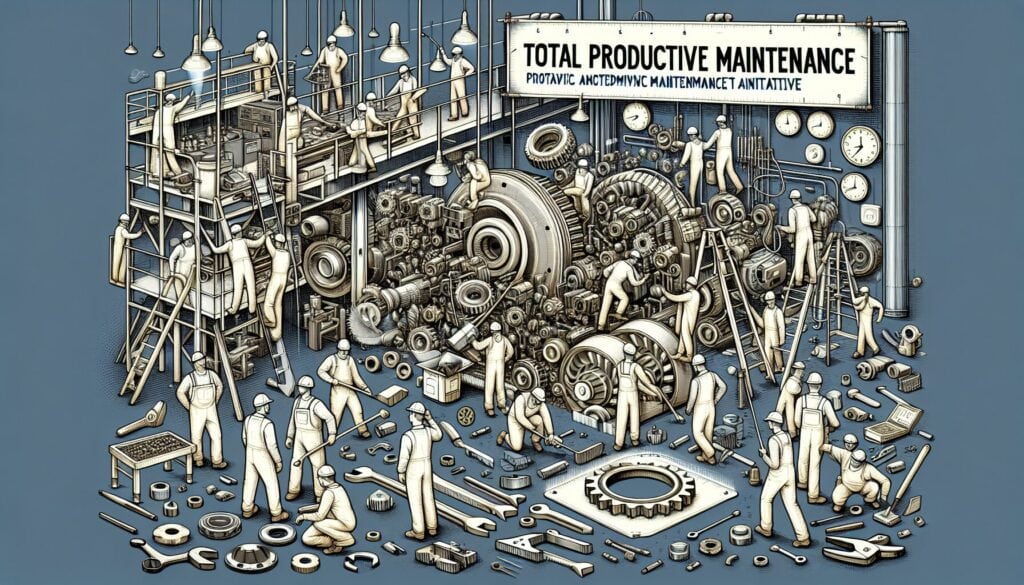To achieve near-perfect production (no breakdowns, no small stops or slow running, no defects, and no accidents) through a proactive, holistic approach involving all employees in equipment maintenance.
- Methodologies: Engineering, Quality
Total Productive Maintenance (TPM)

Total Productive Maintenance (TPM)
- Continuous Improvement, Lean Manufacturing, Lean Production, Maintenance, Overall Equipment Effectiveness (OEE), Process Improvement, Productivity, Quality Management, Safety
Objective:
How it’s used:
- A system of maintaining and improving the integrity of production and quality systems through machines, equipment, processes, and employees that will add business value to an organization. It emphasizes empowering operators to help maintain their equipment (autonomous maintenance).
Pros
- Increases equipment effectiveness (OEE) and reliability; Reduces downtime and maintenance costs; Improves safety and product quality; Enhances employee involvement and morale.
Cons
- Requires a significant cultural shift and long-term commitment; Can be costly and time-consuming to implement fully; Requires extensive training for operators and maintenance staff.
Categories:
- Engineering, Human Resources, Lean Sigma, Manufacturing, Quality
Best for:
- Maximizing equipment effectiveness and lifespan through a comprehensive, proactive maintenance strategy involving all employees.
Total Productive Maintenance (TPM) is widely applicable across various industries, particularly in manufacturing, automotive, and food processing, where equipment uptime is essential for maintaining production efficiency and quality. In the context of project phases, TPM can be integrated during the design and development stages, where input from operators can lead to more maintainable equipment designs that enhance operational performance. It often involves cross-functional teams that include maintenance personnel, production staff, and quality control experts who collaborate to identify areas of improvement and implement preventative measures. Initiated by management, TPM relies on the involvement of all employees, encouraging them to take ownership of the machines they operate, which builds a culture of continuous improvement and problem-solving. For instance, in the automotive industry, adopting TPM principles has led to significant reductions in equipment failure and unplanned downtime, enabling companies to improve their Overall Equipment Effectiveness (OEE) by closely monitoring the performance metrics and making data-driven decisions. Employees who participate in TPM initiatives also report increased job satisfaction and sense of ownership, translating into improved morale and productivity. This methodology not only targets maintenance tasks but focuses on a holistic approach to enhance process capabilities, ensuring that organizations can quickly adapt to changes in demand or production methods while maintaining high safety and quality standards.
Key steps of this methodology
- Conduct initial equipment assessment to identify current condition and maintenance needs.
- Implement autonomous maintenance by training operators to perform routine checks and minor repairs.
- Establish regular maintenance schedules for preventive and predictive maintenance tasks.
- Standardize operating procedures to ensure consistent performance and reduce variability.
- Integrate TPM principles into daily work processes for continuous improvement.
- Conduct root cause analysis for breakdowns and implement corrective actions to prevent recurrence.
- Engage all employees in TPM activities to foster a culture of shared responsibility.
- Utilize visual management tools to track maintenance progress and equipment status.
Pro Tips
- Implement a structured training program for operators to recognize early signs of equipment issues, enhancing early intervention and preventive measures.
- Utilize data analytics for real-time monitoring, enabling predictive maintenance and optimized scheduling to minimize disruptions.
- Encourage cross-functional teams to assess and analyze equipment performance, ensuring diverse input and innovative solutions for continuous improvement.
To read and compare several methodologies, we recommend the
> Extensive Methodologies Repository <
together with the 400+ other methodologies.
Your comments on this methodology or additional info are welcome on the comment section below ↓ , so as any engineering-related ideas or links.
Historical Context
1962
1970
1972
1980
1980
1986
1986
1960
1963
1970
1980
1980
1980
1986
1987
(if date is unknown or not relevant, e.g. "fluid mechanics", a rounded estimation of its notable emergence is provided)















Related Posts
METS to Calories Calculator
Meta-Analysis
Message Mapping
Mental Model Diagrams
Maximum Acceptable Pushing and Pulling Forces
Material Requirements Planning (MRP)